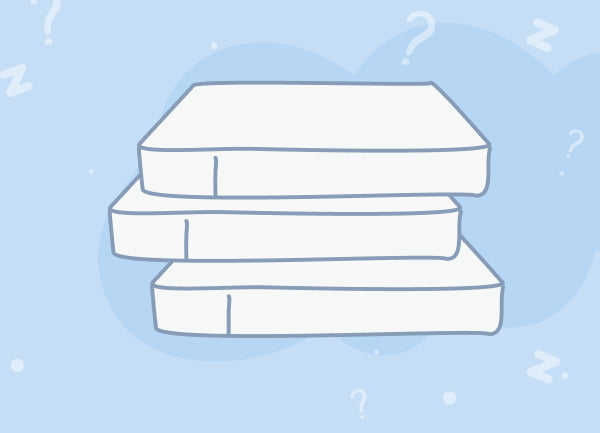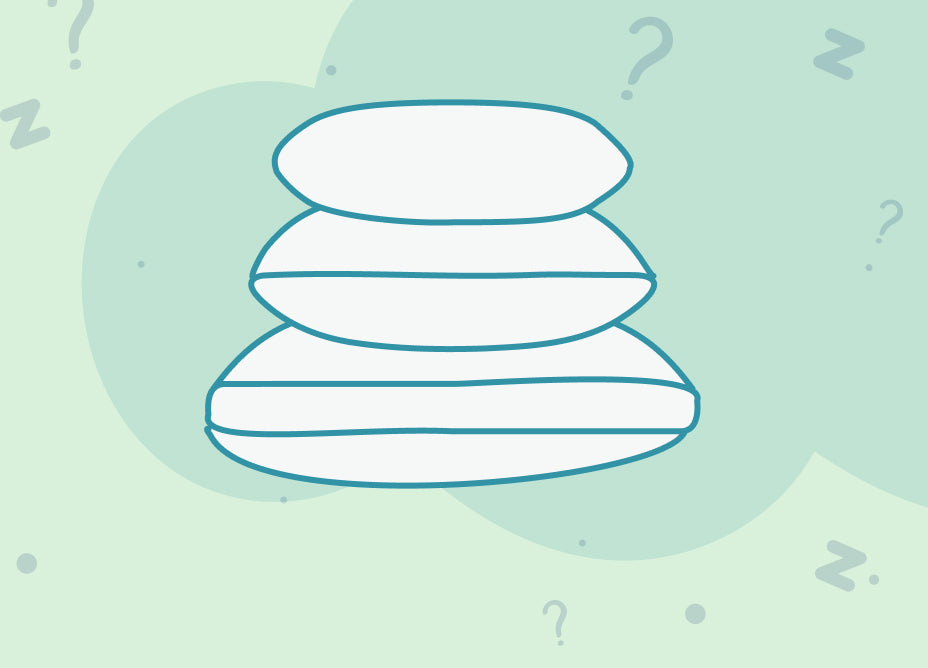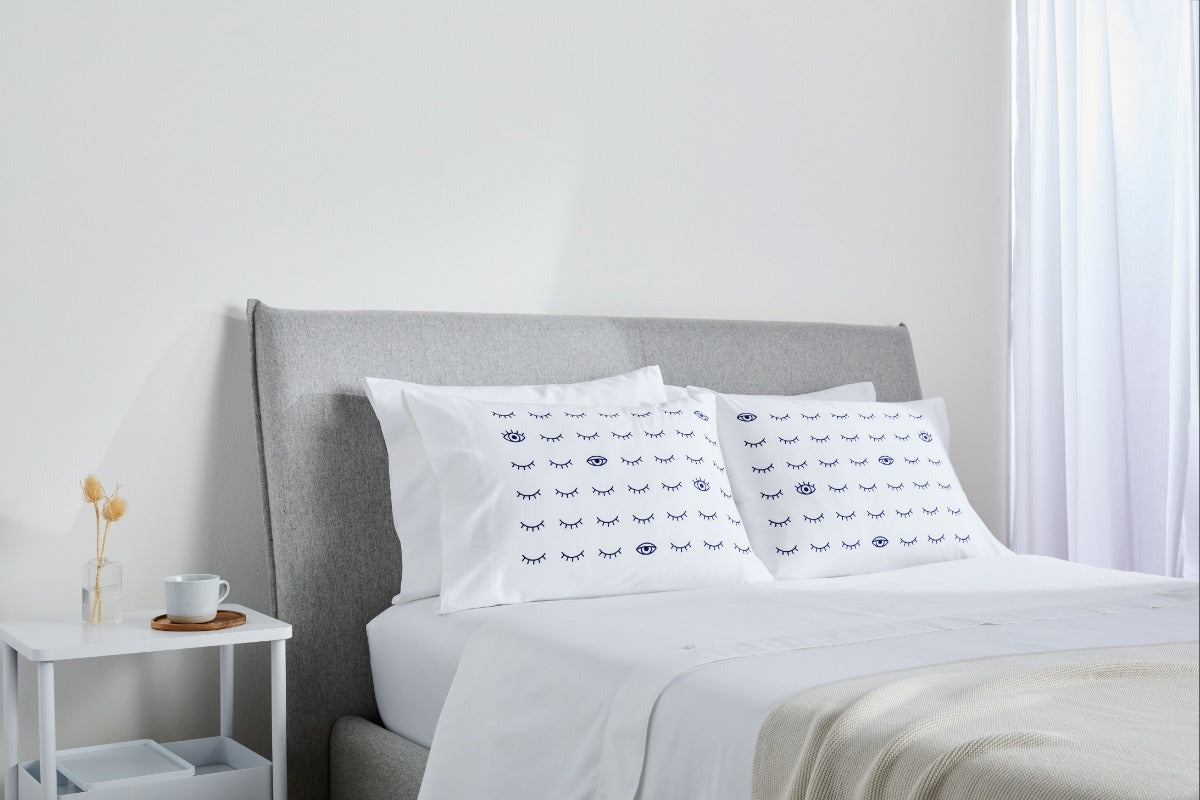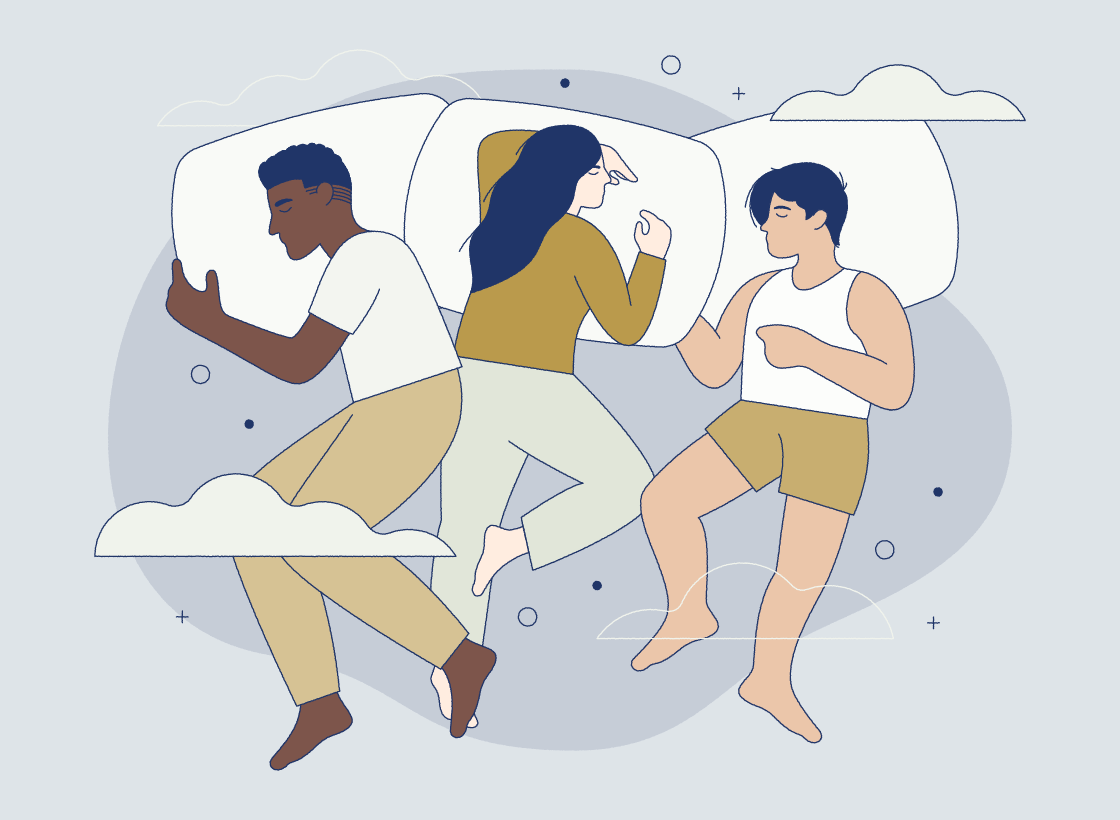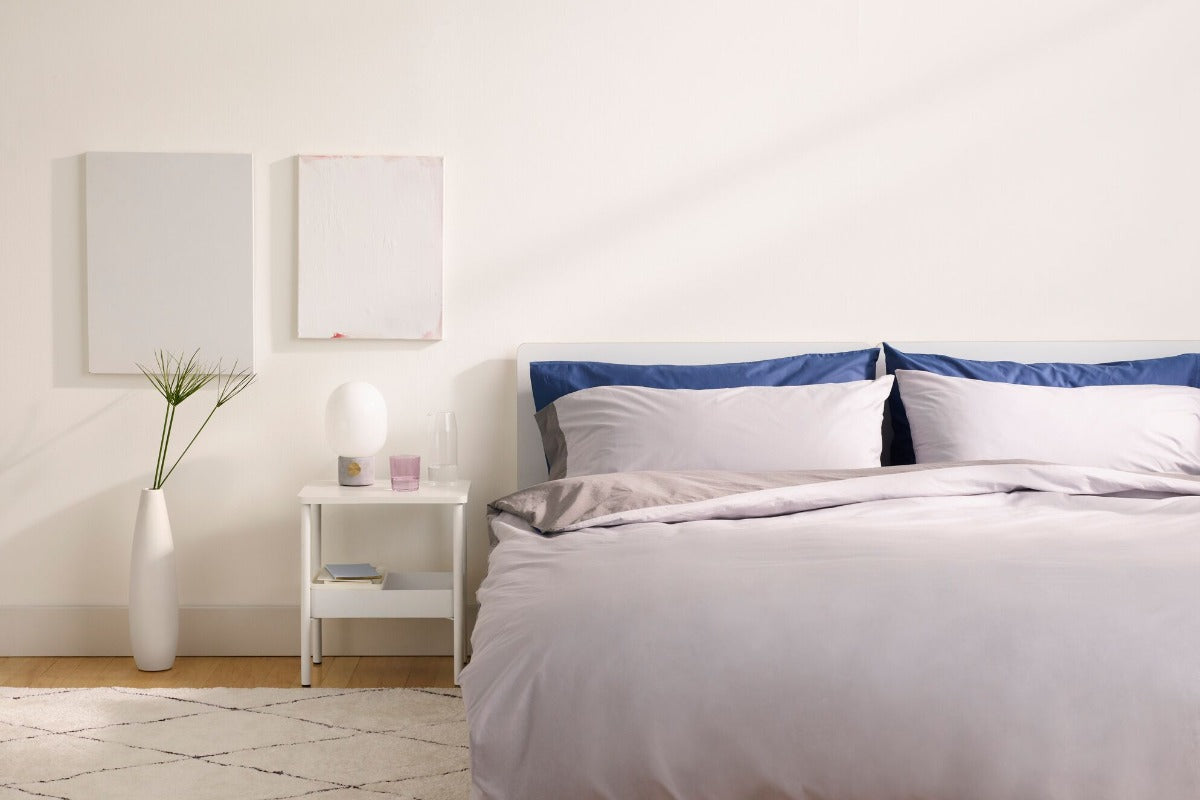Updated May 28, 2025
As you look for the mattress that’sjust right for a bedroom or guest room, you want to consider every option. This leads many people to wonder—what is the difference between a double bed vs full?
This is actually a trick question. There’s no real difference when comparing a double vs full bed. Both a full-size mattress and a double mattress have the same bed dimensions—54” wide by 75” long.
In this guide, we’ll explain how the full-size bed found itself with two names, discuss how to determine if it’s the right sleep surface size for you, and give you a few pointers on how to choose the perfect bedding. You’ll be sleeping soundly in your happily-ever-after bed in no time.
What Is a Double Bed?
The double bed's name stems from its size in relation to a twin-sized bed. Mattress manufacturers began standardizing their sizes shortly after the Civil War, so in the late 19th century, people were limited to only two standard bed sizes: “single bed” (what we now call a twin mattress) and “double bed.” While the name “double” suggests that this mattress is twice as large as a twin bed, it’s only 16” wider than a twin-size mattress, which is 38” by 75”. “Full” or “double” mattresses are thus named because they can sleep two people rather than one.
What Is a Full-Size Mattress?
Think of a full-size mattress as the modern name for what used to be called a double bed. Same dimensions, just a fresher title. Today, “full” is the more common term you’ll see when shopping, but don’t let the label fool you—it’s the same classic size that’s been offering comfort for decades, just dressed up with a new name tag.
Full vs Double Mattress: Why the Different Names?
You might be pondering the question, why are there two different names for mattresses that are the same size?
After all, there’s no other difference when it comes to a full vs double bed.
That’s because the names come from different points in mattress history. “Double” was the original term, used when couples first started cozying up on something wider than a single bed. Later on, “full” gained traction—especially in retail and marketing—as manufacturers modernized their product lines. So today, whether you call it a double or a full, you’re talking about the same classic 54" x 75" sleep space.
The Pros and Cons of a Full or Double Bed
You may be wondering if a full-size mattress is right for you—or if a full bed is big enough for two.
As we’ve already noted, a full-size mattress is not a single sleeper. It definitely has the extra space available to fit two people. After all, couples slept in beds of this size for most of the 20th century.
However, it’s worth weighing the pros and cons of this bed size.
Benefits of the Full-Size Mattress
Sure, a full-size bed is an excellent excuse to snuggle your partner (or if you’re sleeping alone, sprawl out from end to end). But the advantages don’t end there. You can also look forward to these more practical benefits:
-
Less bed means more room in the bedroom – If you have a small living space, you definitely want as much extra space as possible to move around. With a standard king or queen-sized bed, you might find it challenging to open your closet doors, make room for your bureau, and generally give your bedroom a spacious, uncluttered feel. In cases like these, a double mattress can be ideal. You’ll save at least six inches in width along with five inches in length.
-
They have plenty of room for one person – A twin bed doesn’t give an adult much room to toss, turn, and spread out. On the other hand, a full-size mattress provides more than enough sleeping space for a single person—yes, even if you like to sprawl out on your back like a sleepily content starfish.
-
Cost – Because a full-size memory foam mattress requires less material to manufacture, it’s usually less expensive than a queen and king-size mattress.
-
Compatibility with headboards and frames – Love vintage and antique furniture? Purchasing a full-size single mattress could open up a world of options in the decor department. Since most beds were full-size until 1950, you’ll find that Victorian, Shaker, and Art Deco bed frames are ideal for your mattress.
Another important question would be, can a full-size mattress fit a queen headboard? Yes! While there is a difference in size when comparing a full vs queen mattress, you can still pass with a queen headboard or bed frame. There are plenty of ways to adjust a queen headboard to a full-size mattress. If you’re unsure of how to pick a frame for any size mattress, consult our bed frame size chart before you make your choice.
Disadvantages of a Full-Size Mattress
Although there are plenty of reasons to fantasize about your prospective plush double bed, there are some cases where you might want to opt for a bigger mattress. Potential cons of double mattresses include:
-
Less length – Full-sized beds are only 75” long—and considering that few people sleep with the tops of their heads pressed against the headboard, this means that taller people may find them uncomfortable. If you’re well over six feet tall, you may find yourself hitting your head on your headboard or struggling to find room for your feet. In this case, it’s crucial to consider which type of mattress is best for your body—a longer bed, like an 80” king or queen-size mattress, could be ideal.
-
Less length space to toss and turn – While many couples find full-size beds comfortable, some prefer more sleeping space so that they can change positions without elbowing each other in the middle of the night. Likewise, couples who sleep with their pets or kids might enjoy having a 60” wide queen mattress or a 76” wide king mattress.
Full or Double Beds vs. Other Standard Mattress Sizes
The double or full bed size was the standard mattress size for couples up until the 1950s. At that time, manufacturers began to make the standard king-size mattress and queen bed dimensions longer to accommodate a taller population. Today, mattress options have expanded to suit every kind of sleeper—whether you’re furnishing a compact guest room, stretching out solo, or sharing space with a partner, pet, or both.
Full or Double Bed vs. Twin Size Bed
The standard size of twin mattresses measures at 38" x 75", making it 16 inches narrower than a double. Both share the same length, but a double gives solo sleepers more room to stretch out. Twin-size mattresses are great for kids or smaller rooms, while doubles are a more generous upgrade for teens or adults who want a bit more wiggle room.
Full or Double Bed vs. Twin XL Size Bed
A Twin XL mattress is the same width as a twin—38 inches—but adds 5 extra inches of length, measuring 80" long. That makes it ideal for taller sleepers who don’t need extra width. A double, at 54" x 75", offers more side-to-side space but less legroom, so your choice depends on whether width or length is more important.
Full or Double Bed vs. Queen Size Bed
A queen bed bumps things up to 60" x 80", giving sleepers 6 more inches of width and 5 more inches of length than a double. That added space makes it the go-to for couples who want to spread out. If your room size allows, a queen-size mattress offers more comfort for two without venturing into king-sized territory.
Full or Double Bed vs. King Size Bed
A king-size mattress is 76" wide and 80" long—offering a whopping 22 extra inches in width compared to a double. That’s enough space for couples, kids, pets, or all of the above. But it also requires a much larger room to accommodate its footprint. Doubles are better suited for compact spaces or solo sleepers who value coziness and simplicity.
Full or Double Bed vs. California King Size Bed
California king mattresses measure 72" wide by 84" long, making them both longer and slightly narrower than a standard king. Compared to a double, they offer 18 extra inches in width and a full 9 inches in length—ideal for tall sleepers or anyone who wants serious sprawl space. Double beds, on the other hand, are compact and space-conscious, perfect for cozier setups.
How to Find the Perfect Bedding for a Full Bed
Bringing a new bed home is like taking the next step in a relationship. You’ve shopped around for the right bed. You found one with all qualities you’re looking for, and now you’re ready to make a long-term commitment—asking them to move in with you.
And now that this bed is going to be a permanent fixture in your life, you want to impress them with the right decor—or in this case, bedding.
If you’re looking for the perfect bedding, there are a few key pieces to shop for, including:
The Most Comfortable Sheets
If you’ve spent time wandering through the home goods aisles, the odds of hearing someone say, “The higher the thread count, the better the sheets!” is pretty, well, high. While thread count usually ranges from 200-800, a higher thread count doesn’t necessarily mean you’re buying better sheets.1
Instead, consider the following factors when looking for your next set of super-soft sheets:
-
Material – The two most commonly used materials are microfiber and cotton. Here’s a brief breakdown of each:
-
Microfiber – Made of fine polyester fibers, microfiber is the more affordable option. They’re soft and less likely to pill than other fabrics, but they’re also not as breathable. They may also irritate individuals with sensitive skin.1
-
Cotton – With so many varieties of cotton sheets to choose from, where do you even start? Jersey sheets are one of the most cost-effective cotton options. They provide that comfortably familiar feel of a worn-in t-shirt, and they also collect heat easily (which is ideal during those chilly winter months).
In contrast, higher-quality cotton sheets are woven with extra-long fibers and are soothingly soft and durable.1 However, many of the famed options, like Egyptian and Pima cotton, come with a higher price tag.
-
Types of weaves – When shopping for bedding, the weave of your sheets probably isn’t high on your list of factors to account for, but it’s one worth considering. The two basic types include:
-
Sateen – As the name suggests, sateen cloth is made with a satin weave,1 resulting in buttery soft sheets.
-
Percale – Created with a basic weave, percale is more simple and crisp than sateen, but it’s also the more durable of the two.1
-
Thread count – While purchasing the highest thread count may not ensure your sheets are the best in all the land, the thread count you choose does have some impact on their quality. The sweet spot lies somewhere between 300-500,2 but you can still find soft sheets with a thread count as low as 200.
-
Mattress depth – Before you make your final decision on a set of sheets, consider the depth of your mattress. Some mattresses, like our Dream Max Hybrid Mattress, have a deep profile at 14” in height. Take the total depth of your mattress (and potential mattress topper) into account to ensure your sheets will accommodate their overall height. All of Casper’s sheets offer an accommodating depth of 18”—plenty of space for all Casper mattresses.
The Perfect Bedspread: Comforters vs Duvets
Bedding isn’t all about the sheets. You also want a bedspread that engulfs you in comfort and pairs perfectly with your needs. And like the great double bed size vs full size debate, choosing the right bedspread comes down to whether you want a duvet or comforter.
If you’re torn between the two, here are some quick facts to help you make a decision:
The Duvet
A duvet is a thick blanket often filled with goose down (the soft undercoating of ducks) or an alternative fill (a synthetic material that mimics the feel of goose down).3 People who use a duvet often place them inside a decorative and cozy duvet cover to match their bedroom’s aesthetic.
Here’s everything you need to know about duvets3:
-
They’re usually only available in white or cream colors.
-
They’re generally fluffier than a comforter.
-
They often provide more warmth than a comforter.
-
They’re easier to keep clean since they’re tucked inside a duvet cover.
The Comforter
A comforter is usually flatter and lighter than a duvet and comes in a variety of patterns and materials. If you’re considering a comforter, here’s a cheat sheet with all the details:
-
They don’t need a cover since they’re available in every design, style, and color of the rainbow.
-
They’re often available in a set that comes with sheets, sometimes making them more affordable than duvets.
Choosing the Perfect Mattress: Casper's Top Picks
For a longer mattress, you may want to invest in a queen-size, king-size, California king-size, or super king-size bed—all of which can accommodate someone who is up to 6 feet 7 inches. Not sure what to get? Take our mattress quiz! to find your best fit, and explore some of our top choices below in any size:
Casper One
The no-brainer mattress choice. Discover affordable memory foam mattresses no matter your budget with the One.
Casper Dream Max
Ergonomically engineered to help relieve pressure & cradle you all night, the Dream Max is our most supportive mattress for your dreamiest sleep.
Casper Snow Max
With our most supportive ergonomics and most innovative cooling features, the Snow Max is the ultimate solution for whatever is keeping you up.
Choose Your Own Adventure With Casper
After sorting out the differences between the double bed size vs full size, you may find yourself looking for the perfect full-size mattress. Well, Goldilocks, look no further. Casper carries the mattress sizes and materials to suit every sleeper – just check out our mattress size guide to find out. Choose between our six mattress sizes and six unique mattress types to find the perfect mix of sleep space and support.
With a 100-night risk-free trial, you can try out our mattress until you’re sure you’ve found your “just right” bed!
No matter what bed size you need, you can find standard bed sizes in stores and at Casper:, including Twin, Twin XL, Full, Queen, King, and California King-size. Find your happily ever after in a Casper bed today.
Sources:
- HGTV. Guide to Buying Sheets. https://www.hgtv.com/design/rooms/bedrooms/guide-to-buying-sheets
- Good Housekeeping. 5 Things to Consider Before Buying Bed Sheets. https://www.goodhousekeeping.com/home-products/best-sheets/a45102/bed-sheets-buying-guide/
- The Spruce. What Is a Duvet? Choosing a Duvet or Comforter. https://www.thespruce.com/duvet-buying-guide-350481
- Vintage House. Standard bed sizes. http://amgvintagehouse.com/furniture-facts/standard-bed-sizes/

